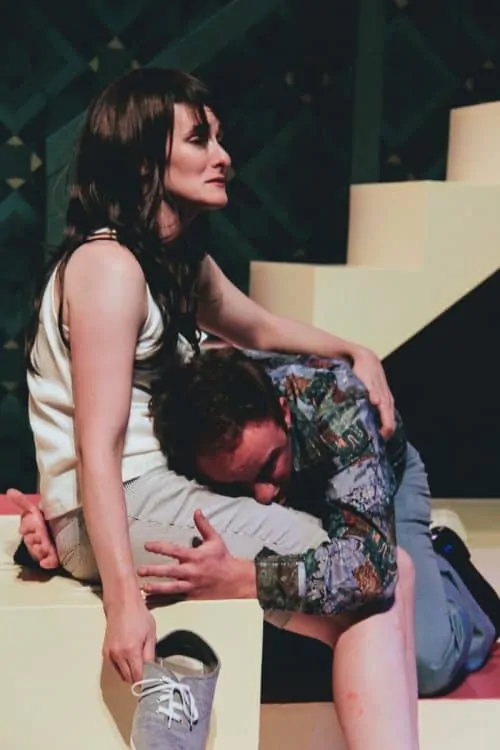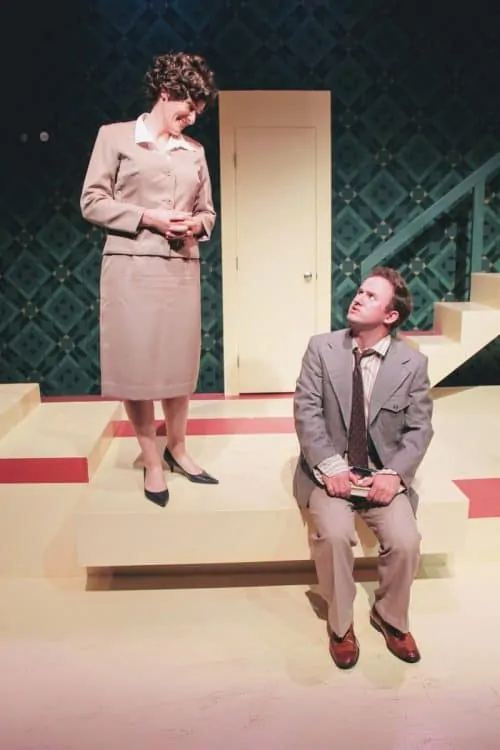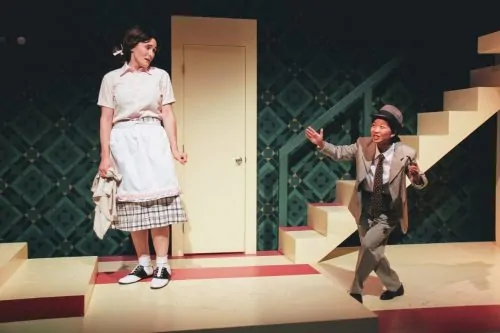The Mineola Twins at Cutting Ball Theater opens with thunder and lightning. The intensity continues unabated throughout the show. Paula Vogel’s play follows a pair of small-town twins as they navigate the trials of sex, potential nuclear war, marriage, electroshock therapy, parenthood, and violent crime. Myra and Myrna have opposite personalities and beliefs, yet their words and actions echo each other strangely, across decades.
Elissa Beth Stebbins plays both twins. Her Myrna in the 50s is a saccharine, wannabe housewife, desperate to be “good.” She’s so over-the-top that Myra is a relief: down-to-earth, smart, and yearning to escape the social constraints of the mid-century. The roller coaster of the twins’ lives gives Stebbins plenty of chance to try on different characters, from drugged-out fugitive (Myra) to a parody of a right-wing talk show host (Myrna). Her retellings of Biblical stories about siblings (the prodigal son from Myrna; Jacob and Esau from Myra) are highlights, thanks to their wry modern twists.
Vogel keeps the play exciting with a mixture of sheer absurdism (including violent dream sequences) and zippy one-liners.
Young Myrna’s older boyfriend Jim is played with exaggerated machismo (and cringe-inducing sexual alacrity) by Sango Tajima in drag. The play’s parallel structure also casts Sango as older Myra’s caring, personable wife, Sarah. Steven Thomas plays both twins’ sons, each painfully earnest. Inevitably, Myrna’s son Kenny is a rebel who wants to run away with Myra, while Myra’s son Ben is an aspiring conservative commentator.
Vogel keeps the play exciting with a mixture of sheer absurdism (including violent dream sequences) and zippy one-liners. We’re introduced to Mineola as a town “so dull, there wasn’t even a red scare here.” Vogel manages to invent a context in which the line, “My sister used my knockers as terrorist camouflage!” actually makes sense. And it’s impossible not to laugh in horror as the hapless older Myrna, ranting on the radio about the perils of multi-culturalism, includes Kristallnacht alongside Kwanza on her list of words that “promote a festive time of year.”



The Exit on Taylor is a tiny theater, and it can be almost frightening to be so close to larger-than-life characters (especially ones with such violent inclinations). Cartoonish acting choices—matched by Michael Locher’s funhouse of a set—keep the energy high but work against the natural intimacy of the space. Director Ariel Craft creates a frantic, unhinged vibe that serves Vogel’s script but often reminds us that we are watching actors rather than characters.
MORE SF Theater by Ilana Walder-Biesanz: Stars align for a memorable ‘Hamlet’ at the ACT
The ending to Vogel’s play is unsatisfying, pulling together various threads without offering a sense of closure. It’s realistic, unlike the rest of the play. It doesn’t seem fair: in a world with sharply drawn personalities and clear dramatic logic, we deserve an obvious ending, and perhaps even a cue for the (well-earned) applause.
Photo credit: Liz Olson
The Mineola Twins
Cutting Ball Theater, San Francisco
4/5


